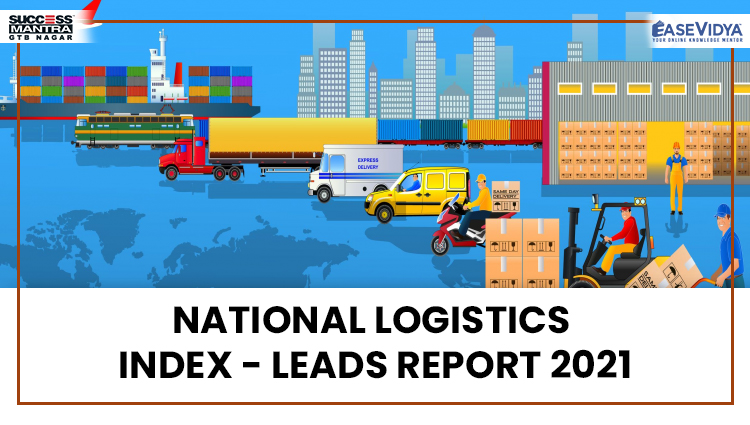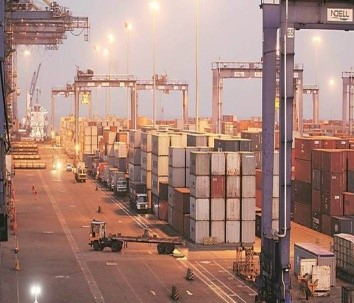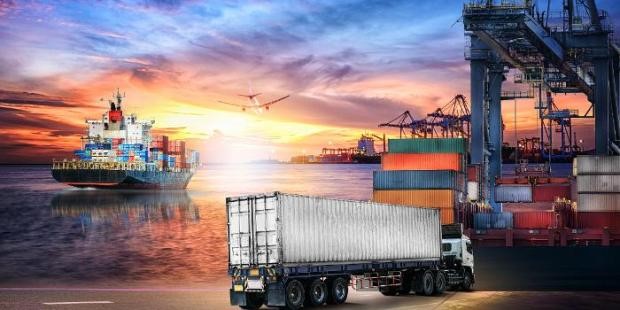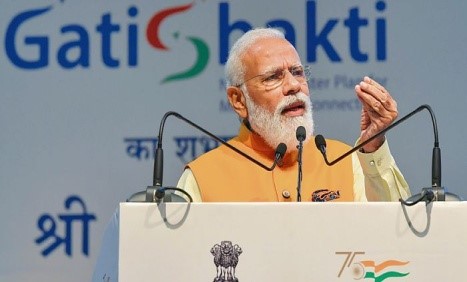
NATIONAL LOGISTICS INDEX LEADS REPORT 2021
NATIONAL LOGISTICS INDEX - LEADS REPORT 2021
Gujarat ranked 1st among 21 states on the national logistics index 2021 chart for its ‘well- developed infrastructure and services driven by a responsive government’. The logistics index chart released in the Logistics Ease Across Different States (LEADS) 2021 report by commerce and industry minister Piyush Goyal assessed the logistics efficiency of states in 2021. Gujarat was ranked number one in the LEADS 2019 index as well. There was no ranking in 2020 due to the COVID-19 pandemic. In the top ten states of LEADS 2021 report, Gujarat is followed by Haryana, Punjab, Tamil Nadu, Maharashtra, Uttar Pradesh, Odisha, Karnataka, Andhra Pradesh, and Telangana. Uttar Pradesh jumped seven places to rank 6th in LEADS 2021 compared to its 13th position in LEADS 2018 report. In the North-Eastern States and Himalayan Union Territories, Jammu and Kashmir ranked at the top. Among other Union Territories, Delhi ranked at the top position.
Gujarat retains no. 1 rank in LEADS 2021 Index for third consecutive year
Gujarat again ranked 1st in the LEADS 2021 Index among 21 states for its ‘proactive policies, well-developed infrastructure and services driven by a responsive government’. Gujarat retained its top position in the 3rd edition of the national logistics index similar to the previous two rankings in 2018 and 2019. Gujarat retains its top position for its logistics efficiency due to its integrated logistics policy and a logistics park policy, creation of institutional framework up till the city level, and creation of suitable port-related infrastructure. Gujarat has ranked on top over 20 other states in indicators such as quality and availability of infrastructure, ease of obtaining all approvals, the extent of facilitation, implementation of LEADS 2019 recommendations such as introducing faceless services in license renewals, widening of roads, expansion of warehousing, etc.

Current Affairs Notes By Success Mantra Coaching Institute GTB Nagar Delhi CLICK HERE
HARYANA, PUNJAB, TAMIL NADU, MAHARASHTRA AMONG TOP 5
Haryana ranked 2nd in the LEADS 2021 Index due to its timeliness of cargo delivery during transportation, quality of warehousing, the efficiency of regulatory services, operating and regulatory environment. Haryana has gained four places to reach the No. 2 rank compared to its No.6 rank in the LEADS 2021 report.
Punjab ranked 3rd in the LEADS 2021 Index for its proactive policies including fiscal incentives under the Industrial and Business Development Policy, single-window clearance mechanism for regulatory approvals, development of warehousing zones, and grievance redressal mechanism. These policies have had a significant effect on the logistic ecosystem however the participating government agencies in the certification process do not have their testing facilities near Ludhiana results in sending samples to Delhi for testing and certification, clearance of imports and exports thereby increasing transaction time. Punjab moved one place down compared to its rank no 2 in the LEADS 2019 report.
Tamil Nadu ranked 4th in the LEADS 2021 Index for its proactive policies such as developing a State Integrated Logistics Plan and granting priority status to logistics. However, Tamil Nadu scored low for poor road infrastructure, road freight rates, and prices of terminal services.
Maharashtra ranked 5th in the LEADS 2021 Index as the state scored low due to poor road infrastructure, poor connectivity, congestion at ports, increased cost of transportation, road freight rates, and prices of terminal services.
NEED OF THE HOUR
India’s logistics costs account for 13-14% of Gross Domestic Product (GDP), compared to 7-8% in developed countries. The government was aiming to bring down logistics costs by 5% over the next 5 years. Estimated logistics costs in India are currently about 14%, which is quite high compared to 8-10% globally. Efficient logistics was pivotal to bring ease and empowerment to businesses as well as citizens. Logistics contributed immensely in our fight against Covid-19 by taking essential supplies including liquid Medical Oxygen throughout the country during the 2nd wave.
WHAT IS THE LEADS INDEX?
The Logistics Ease across Different States (LEADS) Index was launched in 2018 by the Commerce and Industry Ministry and Deloitte. The LEADS Index ranks states on the score of their logistics services and efficiency that are indicative of economic growth. The LEADS 2018 looked into import-export trade and assessed the efficiency of the logistics ecosystem in each state and UT. The LEADS 2019 looked into domestic and international trade. The LEADS 2021 assessed the domestic and EXIM logistics ecosystem of each state. The LEADS 2021 survey was conducted between May to August 2021 that included 21 indicators, 17 perception indicators, and 4 objective indicators. The ranking parameters of each state on the LEADS 2021 Index were based on the availability of logistics infrastructure, timeliness, the competitiveness of pricing, and services. The LEADS Index aims to push states into adopting policies that improve their logistics infrastructure.

RELATED INITIATIVES BY INDIAN GOVERNMENT
PM Gati Shakti Master Plan: The government of India has launched the ambitious Gati Shakti scheme or National Master Plan for multi-modal connectivity plan, with the aim of coordinated planning and execution of infrastructure projects to bring down logistics costs. The Aim is to ensure integrated planning and implementation of infrastructure projects in the next four years, with focus on expediting works on the ground, saving costs and creating jobs. The Gati Shakti scheme will subsume the Rs 110 lakh crore National Infrastructure Pipeline that was launched in 2019. Besides cutting logistics costs, the scheme is also aimed at increasing cargo handling capacity and reducing the turnaround time at ports to boost trade. It also aims to have 11 industrial corridors and two new defence corridors - one in Tamil Nadu and other in Uttar Pradesh. Extending 4G connectivity to all villages is another aim. Adding 17,000 kms to the gas pipeline network is being planned. It will help in fulfilling the ambitious targets set by the government for 2024-25, including expanding the length of the national highway network to 2 lakh kms, creation of more than 200 new airports, heliports and water aerodromes.

Dedicated Freight Corridor (DFC): It is a high speed and high capacity railway corridor that is exclusively meant for the transportation of freight, or in other words, goods and commodities. DFC involves the seamless integration of better infrastructure and state of the art technology.
DFC consists of two arms: Eastern Dedicated Freight Corridor (EDFC) which starts at Sahnewal (Ludhiana) in Punjab and ends at Dankuni in West Bengal. The EDFC route has coal mines, thermal power plants and industrial cities. Feeder routes are also being made for these & Western Dedicated Freight Corridor (WDFC) which is the other arm around 1,500-km WDFC from Dadri in Uttar Pradesh to Jawaharlal Nehru Port Trust in Mumbai, touching all major ports along the way. The WDFC covers Haryana, Rajasthan, Gujarat, Maharashtra and Uttar Pradesh. It is being funded by the Japan International Cooperation Agency.
Sagarmala Programme: The Sagarmala Programme was approved by the Union Cabinet in 2015 which aims at holistic port infrastructure development along the 7,516-km long coastline through modernisation, mechanisation and computerisation. Under this port-led development framework, the government hopes to increase its cargo traffic three-fold. It also includes the establishment of rail/road linkages with the port terminals, thus providing last-mile connectivity to ports; development of linkages with new regions, enhanced multi-modal connectivity including rail, inland water, coastal and road services.
Bharatmala Pariyojana: It is an umbrella program for the highways sector envisaged by the Ministry of Road Transport and Highways. Under Phase-I of Bharatmala Pariyojana, implementation of 34,800 km of national highways in 5 years (from 2017 to 2022) has been approved at an estimated outlay of Rs. 5,35,000 crore. National Highways Authority of India (NHAI) has mandated the development of about 27,500 km of national highways under Phase-I. However, as per ICRA Limited, Phase-I is likely to be delayed by four years due to the prevailing uncertainty due to Covid-19 and consequent impact on valuations.
ICRA Limited is an Indian independent and professional investment information and credit rating agency. Phase-II envisages around 48,000 km of road network across India by 2024.
Objectives: To optimise the efficiency of freight and passenger movement across the country by bridging critical infrastructure gaps through effective interventions. The effective interventions include the development of economic corridors, inter corridors and feeder routes, national corridor efficiency improvement, border and international connectivity roads, coastal and port connectivity roads and greenfield expressways.
Current Affairs Notes By Success Mantra Coaching Institute GTB Nagar Delhi CLICK HERE
TEST YOURSELF
Q.1 Which of the following states has been ranked 1st among 21 states on the national logistics index 2021 chart for its ‘well-developed infrastructure and services driven by a responsive government’?
- Maharashtra
- Gujarat: ANSWER
- Tamil Nadu
- Karnataka
Q.2 Which of the following Union Ministers released the logistics index chart in the Logistics Ease Across Different States (LEADS) report 2021?
- Piyush Goyal: ANSWER
- Ashwini Vaishnaw
- Raj Kumar Singh
- None of the following
Q.3 Which of the following have launched the PM GatiShakti- National Master Plan for multi-modal connectivity worth Rs. 100 lakh crores?
- Nirmala Sitharaman
- PM Narendra Modi: ANSWER
- Hardeep Singh Puri
- None of the following
Q.4 Consider the given statements & state which of the following is/are correct in the reference to the above mentioned passage?
- The plan of Gati-Shakti was announced by PM Modi during his address on Mahatma Gandhi Jayanti on 2nd October 2021.
- PM Gati-Shakti will incorporate the infrastructure schemes of various ministries and state governments such as Sagarmala, Bharatmala, land ports, inland waterways, and UDAN.
- Only I follows
- Only II follows: ANSWER
- Both I & II follows
- None of the above
Q.5 Which of the following is correct regarding the amount that is being estimated to be raised through the National Monetisation Pipeline?
- Five thousand crore
- Six thousand crore
- Six lakh crore: ANSWER
- Seven lakh crore













0 Comment